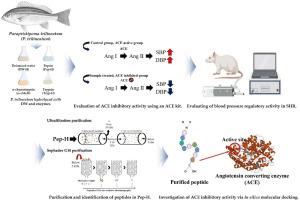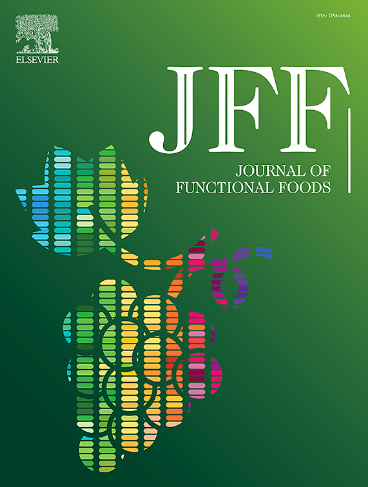Blood pressure regulatory effect of enzyme-assisted hydrolysate from Parapristipoma trilineatum by regulation of angiotensin II and ACE: Identification of ACE inhibition through in silico molecular docking
IF 4
2区 农林科学
Q2 FOOD SCIENCE & TECHNOLOGY
引用次数: 0
Abstract
This study investigated the blood pressure-regulating effects of a pepsin-assisted hydrolysate from Parapristipoma trilineatum (PepH) through both in vitro and in vivo studies. P. trilineatum was hydrolyzed with deionized water and three enzymes (α-chymotrypsin, trypsin, and pepsin). After enzymatic hydrolysis, the ACE inhibitory potential of the hydrolysates was evaluated. Among them, PepH exhibited the strongest ACE inhibitory activity, leading to its selection for subsequent in vivo studies. PepH administration significantly reduced systolic blood pressure and ameliorated hypertension-induced tissue damage in the aorta and heart. Furthermore, PepH significantly decreased serum Angiotensin II (Ang II) and Angiotensin-Converting Enzyme (ACE) levels. Furthermore, in silico molecular docking confirmed that purified peptides strongly bound to the active site of ACE. Collectively, our results suggest that PepH lowers blood pressure and protects against hypertension-induced tissue damage in SHRs. PepH shows potential as a functional food for managing hypertension and preventing related tissue damage.

三叶旁藤酶助水解物对血管紧张素II和ACE的调节作用:通过硅分子对接鉴定ACE抑制作用
本研究通过体外和体内研究,探讨了三叶旁尖瘤(PepH)胃蛋白酶辅助水解物的血压调节作用。用去离子水和三种酶(α-凝乳胰蛋白酶、胰蛋白酶和胃蛋白酶)水解三联藤。酶解后,评价酶解物的ACE抑制电位。其中,PepH表现出最强的ACE抑制活性,因此被选为后续的体内研究。PepH可显著降低收缩压,改善高血压引起的主动脉和心脏组织损伤。此外,PepH显著降低血清血管紧张素II (Ang II)和血管紧张素转换酶(ACE)水平。此外,在硅分子对接中证实纯化肽与ACE活性位点紧密结合。总的来说,我们的研究结果表明,PepH降低了shr患者的血压,并保护他们免受高血压引起的组织损伤。PepH作为一种功能性食品具有控制高血压和预防相关组织损伤的潜力。
本文章由计算机程序翻译,如有差异,请以英文原文为准。
求助全文
约1分钟内获得全文
求助全文
来源期刊

Journal of Functional Foods
FOOD SCIENCE & TECHNOLOGY-
CiteScore
9.60
自引率
1.80%
发文量
428
审稿时长
76 days
期刊介绍:
Journal of Functional Foods continues with the same aims and scope, editorial team, submission system and rigorous peer review. We give authors the possibility to publish their top-quality papers in a well-established leading journal in the food and nutrition fields. The Journal will keep its rigorous criteria to screen high impact research addressing relevant scientific topics and performed by sound methodologies.
The Journal of Functional Foods aims to bring together the results of fundamental and applied research into healthy foods and biologically active food ingredients.
The Journal is centered in the specific area at the boundaries among food technology, nutrition and health welcoming papers having a good interdisciplinary approach. The Journal will cover the fields of plant bioactives; dietary fibre, probiotics; functional lipids; bioactive peptides; vitamins, minerals and botanicals and other dietary supplements. Nutritional and technological aspects related to the development of functional foods and beverages are of core interest to the journal. Experimental works dealing with food digestion, bioavailability of food bioactives and on the mechanisms by which foods and their components are able to modulate physiological parameters connected with disease prevention are of particular interest as well as those dealing with personalized nutrition and nutritional needs in pathological subjects.
 求助内容:
求助内容: 应助结果提醒方式:
应助结果提醒方式:


